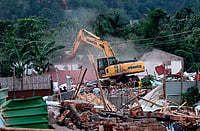But much of that is changing. Today, the two communist, ex-colonial (one French, the other British) states are trading central planning and control for economic liberalisation and increasing economic interaction. With their common communist ideology as the base, the two cities have developed much closer business links. According to India's ambassador to Vietnam, S.L. Malik, a clutch of Calcutta-based companies is currently exploring investment opportunities in Vietnam.
These include the Ispat group, which is close to finalising a $27-million deal to produce 30,000 tonnes of galvanised steel near Hanoi; the RPG group is negotiating three projects—managing a 5,000 hectare rubber plantation in south Vietnam, starting an automotive tyre plant in Danang in central Vietnam, and constructing electricity transmission towers at a cost of $7 million at a site north of Hanoi.
Tobacco and hotel giant ITC has bagged a licence to open a representative office in Hanoi, and a delegation from Calcutta-based pharmaceutical firms visited Hanoi last year with a view to doing business.
The flow from the Vietnamese side is a lot slower, though several Vietnamese firms participated in an exhibition organ-ised by the Calcutta Chamber of Commerce and Industry in Calcutta last year.
Despite their communist orientation and the occasional jibes at their bete noire, the US, both governments are wooing foreign investment and expanding their infrastructural base. Anti-imperialist graffiti defaces buildings in Calcutta. In Hanoi, Vietnamese General Secretary Do Muoi frowns on US efforts to urge Hanoi to improve its human rights record. Still, both cities welcome American officials who come to do business, and not deliver homilies.
With its flourishing stock market, Calcutta can teach Hanoi a thing or two about running a bourse. Efforts by Hanoi to start its first stock market were sloppy. Lacking a roster of successful companies that could be listed, the attempt was akin to putting the cart before the horse. Moreover, instead of privatising its profitable firms, Hanoi is trying to sell shares in its loss-making state firms.
Vietnam has been run by the Communist Party of Vietnam (CPV) since the defeat of the US forces and the fall of Saigon in 1975. Just two years later, the Communist Party of India (Marxist) romped to power in the state of West Bengal and made Calcutta the seat of the state's first communist government. Soon after, the CPI(M) renamed Calcutta's Harrington Street as Ho Chi Minh Sarani, a tribute to the founder of modern Vietnam. His bust also graces a prominent Calcutta park on Jawaharlal Nehru Road, several blocks away from another symbol of state control, a full-figure statue of Lenin. The Vietnamese government reciprocated by creating the Indira Gandhi Park at a prominent site adjacent to the Government Guest House in Hanoi.
But despite common communist leanings, the CPI(M) in Calcutta and the CPV in Hanoi remain far apart politically. The CPI(M) supremo in West Bengal, Jyoti Basu, has held uninterrupted office since his party came to power in 1977. The CPV has no supremo. The party follows a collective style of leadership where the general secretary, prime minister and most of the 16-member politburo are replaced at a party Congress held every five years. The Eighth Congress is scheduled for June this year when the current General Secretary, Do Muoi, and Prime Minister Vo Van Kiet, both in their 70s, are expected to be replaced by younger men. "Like in Calcutta politics, a man aged 60 is considered young in the CPV," remarked a veteran Indian businessman in Hanoi.
The presence of a vociferous opposition in the West Bengal Assembly prevents the CPI(M) from functioning as an absolute power, while the CPV's power pervades all levels of the state. Elections are choreographed by the party's organ, the Fatherland Front, which vets candidates for elections to the National Assembly, or parliament. The result is that Hanoi, which bans unions and outlaws public gatherings, can implement projects quicker than the state government in Calcutta, where powerful trade unions and vested interests combine to slow the pace of development.
It took just two years for Hanoi to build a 30-km highway linking its Noi Bai air-port to the city, clearing slums, farmlands and squatters along the route. Calcutta's experience in clearing slumdwellers along Bridge No 4, connecting Park Circus to the Eastern Metropolitan bypass on the way to the airport, has been less successful. Squatters along the bridge have built permanent dwellings and places of worship, scuttling plans to widen and repair the bridge.
One of the more beautiful Indian cities, Calcutta has a lot going for it. But the average Calcuttan tends to be cynical. "Shah Jahan built the Taj Mahal in 20 years. Jyoti Basu built the second Howrah bridge in 21 years," said a businessman, as he sipped pink gin at the British colonial-style Bengal Club.
But one thing that the two cities definitely have in common, says a European diplomat in Hanoi, is that they are possibly the last bastions of Asian culture in a continent that has all but erased its heritage. The two capitals are among a shrinking number of Asian cities where rickshaws (hand pulled in Calcutta and cyclos or peditrishaws in Hanoi) still ply on streets lined with colonial and pre-colonial buildings. Most of Asia's booming Pacific Rim countries, from Japan to Singapore, on the other hand, have become or are fast becoming western urban clones.
While the British built impressive landmarks such as the Victoria Memorial, St Paul's Cathedral, Writers' Buildings and an enviable stock of prime turn-of-the-century properties, the French built fewer buildings of distinction such as the Hanoi Opera House, the art-deco presidential palace, and the 5,520-ft long Doumer Bridge. But a blight of neglect threatens the architecture of both cities. A French-built cathedral in Hanoi is falling to pieces, and will probably collapse soon because CPV cadres do not care about a symbol of a western religion. Besides, it lacks any commercial value. Many Calcutta buildings along the Esplanade and at Chowringhee are similarly endangered.
Though the French language is rapidly losing relevance in Hanoi, some French habits die hard. Every street corner has a stall selling French paté and French bread, never mind if it was prepared in a dubious back street bakery. Pork-filled French loaves on Trang Tien Street are nevertheless the rough equivalent of kathi chicken rolls on Park Street.
It is just as expensive to eat out in Calcutta as it is in Hanoi, which has quickly shrugged off its sick man of Southeast Asia image, and now faces a glut of restaurants—including a two month-old north Indian restaurant owned by a Hong Kong-based Indian.
The people of both cities have no affinity for effete communist ideology; they want to get ahead with their lives. The communist regimes they live under are, thankfully, showing signs of changing with the times.

























